Ah, quiche. That glorious French creation, always a welcome sight on a picnic blanket, a casual weeknight dinner table, or a celebratory spread. But the real magic lies in getting the baking time and temperature just right. You want a golden, flaky crust, a silky, custardy filling, and – let's be honest – no soggy bottom. That’s where my expertise comes in, my fellow quiche enthusiasts. I’m ready to share my secrets, gleaned from countless baking experiments, to help you achieve quiche perfection.
(Part 1)
Understanding the Fundamentals

Before diving into the details of time and temperature, we need to lay down some groundwork. You see, the success of your quiche depends on a delicate balance of factors – from the crust you choose to the type of filling you’re using.
The Crust’s Role
Think of the crust as the foundation of your quiche, the sturdy base that holds it all together. Its type will directly impact how long your quiche needs to bake. A classic pastry crust, made from scratch, will require a bit more time than a pre-made crust, already baked. It’s a matter of getting that pastry fully cooked and golden.
The Filling's Influence
Now, the filling. This is where things get interesting. The type and quantity of your filling play a crucial role in determining baking time. For example, a quiche bursting with creamy cheese or a luxurious amount of cream will take longer to set than a simple, vegetable-based one. It all comes down to how much moisture needs to evaporate and how the ingredients need to bind together.
The Golden Rule: Baking Time

(Part 2)
The Average Baking Time
As a general rule, a classic 10-inch quiche will spend about 30 to 45 minutes in a preheated oven at 350°F (180°C). But this is just a starting point. We need to factor in the size of your quiche, the type of crust, and the specific ingredients in your filling.
The Tell-Tale Toothpick Test
The best way to know if your quiche is ready is by using the trusty toothpick test. Gently insert a toothpick into the center of the quiche. If it comes out clean, or with just a few moist crumbs clinging to it, you're good to go. If the toothpick still has a lot of wet filling on it, give your quiche a few more minutes in the oven.
Important Notes on Baking Time
Remember, every oven is a little different, so don't be afraid to check your quiche a little earlier than the minimum time. Also, always let your quiche cool slightly before slicing into it. This will give the filling a chance to set properly and prevent a runny mess.
Baking Temperature: The Key to Success

(Part 3)
Finding the Sweet Spot
The ideal baking temperature for a quiche is 350°F (180°C). This temperature is high enough to cook the crust and set the filling without burning the top. However, you might need to make small adjustments depending on your oven and the type of quiche you're making.
Adjusting the Temperature for Different Quiches
For example, if you're using a pre-made crust, reducing the temperature to 340°F (170°C) might prevent the crust from over-browning. If your oven is known for running hot, consider lowering the temperature slightly as well.
Avoiding the Dreaded Soggy Bottom
A high initial oven temperature is crucial for creating a crispy, flaky crust. This is particularly important for classic pastry crusts, as they can become soggy if the oven isn’t hot enough. So, make sure your oven is preheated to the correct temperature before sliding your quiche in.
Tips for Quiche Baking Time and Temperature
(Part 4)
Choosing the Right Baking Pan
The right pan can make a world of difference. Use a pan that’s the perfect size for your quiche, leaving about ?? inch of space at the top for the filling to rise. And remember, dark-coloured pans absorb more heat, so you might need to reduce the baking temperature a bit.
The Importance of blind baking
If you're working with a classic pastry crust, blind baking it before adding the filling can help prevent a soggy bottom. This involves pre-baking the crust for about 10-15 minutes, weighing it down with baking beans or pie weights to prevent it from puffing up. This ensures the crust is fully cooked before the filling goes in, resulting in a beautifully crisp base.
Avoid Overfilling Your Quiche
Resist the temptation to overfill your quiche. Leave some room at the top for the filling to set properly. Overfilling leads to a runny filling and an uneven, potentially burnt, top.
The Baking Sheet Trick
For even baking, place your quiche pan on a baking sheet in the oven. This will help prevent the bottom from burning while the top cooks evenly.
Keep an Eye on Your Quiche
Always use the toothpick test, but don't rely solely on it. Keep a watchful eye on the top of your quiche. It should be golden brown and slightly puffed up. The filling should be set and not jiggly. If the top starts to brown too quickly, cover it with foil for the last few minutes of baking.
Quiche Varieties: Baking Time and Temperature Adjustments
(Part 5)
The Classic Quiche Lorraine
This timeless quiche features a delightful combination of bacon, eggs, and cream. A standard 10-inch quiche lorraine will typically spend about 35 to 40 minutes in a preheated 350°F (180°C) oven. The bacon adds a delicious richness, and the cream creates that silky, smooth texture we all love.
Vegetable Quiche: A Rainbow of Flavor
A vegetable-packed quiche is a fantastic way to use up leftover vegetables and create a vibrant, flavourful dish. The baking time for a vegetable quiche will depend on the specific vegetables you use. Vegetables that require a longer cooking time, such as broccoli or cauliflower, will need to be pre-cooked before adding to the filling. A typical vegetable quiche will take around 30 to 35 minutes in a preheated 350°F (180°C) oven.
Quiche with Cheese: Decadent Delights
A quiche with cheese is a decadent treat, adding a delightful richness to the dish. A cheese quiche will generally take about 35 to 40 minutes to bake, but keep a close eye on it, as cheese can burn easily. If you're using a large amount of cheese, you might want to reduce the oven temperature slightly.
Mini Quiches: Bite-Sized Perfection
If you’re making mini quiches, you'll need to adjust the baking time accordingly. They will usually take about 15 to 20 minutes in a preheated 350°F (180°C) oven. Keep an eye on them, as they can burn quickly.
Troubleshooting Common Quiche Baking Issues
(Part 6)
The Soggy Crust Problem
A soggy crust is a quiche disaster. This usually happens when the crust isn't cooked through before the filling is added. To prevent this, try blind baking the crust before adding the filling. Make sure you preheat the oven to a high temperature (around 350°F (180°C)) and bake for 10-15 minutes, weighing it down with baking beans or pie weights.
A Runny Filling: Not So Appealing
A runny filling is another common quiche problem. This can happen if you've overfilled the quiche or if the oven temperature is too low. To avoid this, make sure you don’t overfill the quiche, leaving some space at the top for the filling to set. Also, make sure you preheat the oven to the correct temperature and bake the quiche until the filling is set and no longer jiggly.
The Burnt Top Dilemma
A burnt top is a sign that the oven temperature is too high or that the quiche is baking for too long. To prevent this, you can reduce the oven temperature slightly or cover the quiche with foil for the last few minutes of baking. If the top starts to brown too quickly, tent the quiche with foil to prevent it from burning.
The Cracked Crust: A Visual Blemish
A cracked crust is usually due to over-mixing the dough. To prevent this, mix the dough until it just comes together. Avoid over-handling the dough, as this can make it tough.
Storing and Serving Your Quiche
(Part 7)
Storing Leftovers for Later
Let your quiche cool completely before storing it in the fridge. Cover it tightly with cling film or aluminium foil. It will keep well in the fridge for up to 3 days.
Reheating Your Quiche to Its Former Glory
Reheating your quiche is simple. You can reheat it in the oven, microwave, or even under the grill. To reheat it in the oven, place it in a preheated oven at 320°F (160°C) for about 15 minutes. For the microwave, simply heat it on a medium setting for about 30 seconds to 1 minute.
Serving Suggestions: A Feast for the Senses
Quiche is incredibly versatile, so there are endless serving suggestions. Serve it warm or at room temperature. It's delicious on its own, but you can also pair it with a green salad, a side of roasted vegetables, or some crusty bread.
FAQs: Answering Your Quiche Questions
(Part 8)
Here are some frequently asked questions about quiche baking time and temperature:
- Can I freeze quiche? Yes, you can freeze quiche. Simply wrap it tightly in cling film or aluminium foil and freeze for up to 3 months. To thaw, leave it in the fridge overnight. Then, reheat it in the oven, microwave, or under the grill.
- What if my quiche is still wet in the middle? If your quiche is still wet in the middle, it's probably not cooked through. Return it to the oven for another 5-10 minutes, checking it regularly.
- Can I use a different type of crust? You can certainly use a different type of crust. A puff pastry crust, for example, will bake a bit faster than a classic pastry crust. Be sure to check the baking instructions for your specific crust.
- Can I add extra ingredients to my quiche? Absolutely! You can add all sorts of things to your quiche, from fresh herbs and spices to different types of vegetables and meats. Just make sure you adjust the baking time accordingly.
- What’s the best way to prevent a soggy bottom? Blind baking the crust is the best way to prevent a soggy bottom. This involves pre-baking the crust for 10-15 minutes before adding the filling. You can also try lining the pan with parchment paper.
There you have it, my comprehensive guide to achieving perfect quiche baking time and temperature. Remember, the more you bake quiches, the more confident you'll become. Don't be afraid to experiment, and with a little knowledge and patience, you'll be creating delicious, impressive quiches in no time. Happy baking!
Everyone is watching

Corn on the Cob: The Ultimate Guide to Perfectly Cooked Ears
Healthy MealsAh, corn on the cob. Just the name evokes images of sunny days, barbecues, and that sweet, juicy flavour that ...

Perfect Pork Roast Oven Cooking Time: A Guide to Delicious Results
Healthy MealsThere's something truly satisfying about a perfectly roasted pork. The aroma alone is enough to make your mout...

Ham Cooking Time: How Long to Bake, Smoke, or Boil a Delicious Ham
Healthy MealsAh, ham. It's a classic, isn't it? A real crowd-pleaser, especially around holidays. And when done right, it'...

Scallops: The Ultimate Guide to Perfect Cooking
Healthy MealsAh, scallops. Those delicate, sweet, and utterly delicious morsels of the sea. They hold a special place in my...

Spaghetti Squash: The Ultimate Guide to Cooking and Serving
Healthy MealsRemember that time you saw spaghetti squash at the supermarket, looking all bumpy and strange, and thought, "W...
